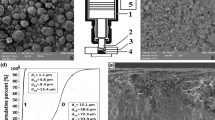Abstract
Attempts have been made to improve the high-temperature corrosion behavior of an intermetallic alloy, Ti–46.7Al–1.9W–0.5Si, in an H2/H2S/H2O atmosphere at 850°C using AlTiN coating with and without CrN and NbN diffusion barriers. The oxidation and sulfidation behavior of the uncoated Ti–46.7Al–1.9W–0.5Si alloy followed protective kinetics with a parabolic rate constant of 6×10−11 g2/cm4/s. A multi-layered scale developed: an outer rutile (TiO2) layer, a continuous layer of α-Al2O3 beneath the rutile layer, and an inner TiS layer, in which pure W was scattered. Fast outward diffusion of Ti within the substrate resulted in the formation of a zone of high concentration of aluminum (TiAl3 and TiAl2) between the scale and substrate.
The use of an AlTiN coating greatly increased the oxidation and sulfidation resistance of Ti–46.7Al–1.9W–0.5Si. The use of NbN and CrN diffusion barriers further enhanced its corrosion resistance. The protection of the double-layer coatings persisted even after 240 hr exposure. However the mismatch of thermal expansion coefficients between the coating and substrate led to the development of cracks in some locations within the coatings. A 2.5 μm thick AlTiN coating on the Ti–46.7Al–1.9W–0.5Si substrate with an embedded defect was modeled using the general finite element (FE) program ABAQUS. The modeling results showed rapid mode I failure of the coating at a temperature of 774°C. The through-fracture of the nitride film caused the nitride coating to shrink back leading to delamination around the crack in the nitride coating. The cracks formed acted as diffusion paths, for the ingress of oxygen and sulfur species and the outward diffusion of substrate elements, which resulted in the formation of nodular corrosion products with similar morphologies and microstructures to the uncoated alloy in those locations where cracks developed.
Similar content being viewed by others
REFERENCES
P. K. Datta, K. Natesan, and J. S. Burnell-Gray, Coatings technology: intermetallic coatings and coatings for intermetallics, invited book chapter: Intermetallic Compounds: Principles and Practice, Vol. 3, Progress, J. H. Westbrook and R. L. Fleischer, eds., to be published by John Wiley, 2002.
M. M. Keller, P. E. Jones, W. J. Porter, and D. Eylon, JOM, 49, 42(1997).
T. Noda, Intermet. 6, 709(1998).
D. M. Dimiduk, Mater. Sci. Engineer. A263, 281(1999).
F. Appel et al., Advanced Engineer. Mater. 2, 699(2000).
R. LeHolm, B. Norris, and A. Gurney, Adv. Mater. Process. 159, 27(2001).
A. Gil, H. Hoven, E. Wallura, and W. Quadakkers, Corros. Sci. 34, 615(1993).
E. H. Copland, B. Gleeson, and D. J. Young, Acta Mater. 47, 2937(1999).
H. L. Du, P. K. Datta, and S. K. Hwang, Mater. Sci. Forum, 251 219(1997).
H. L. Du, P. K. Datta, J. Leggett, J. R. Nicholls, J. C. Bryar, and M. H. Jacobs, in Advances in Surface Engineering, Vol. I, Proc. of Int. Conf. on Advances in Coatings and Surface Engineering, P. K. Datta, and J. S. Burnell-Gray, eds. (Royal Society of Chemistry, Cambridge 1997), pp. 53-66.
Internal Report, University of Northumbria, UK, 1999.
H. L. Du. P. K. Datta, D. B. Lewis, and J. S. Burnell-Gray, J. Mater. Sci. 30, 2640(1995).
H. L. Du, P. K. Datta, D. B. Lewis, and J. S. Burnell-Gray, Mater. Sci. Engineer. A205, 199(1996).
L. E. Toth, Transition Metal Carbides and Nitrides (Academic Press, 1971), p. 6.
G. V. Samsonov and I. M. Vinitskii, Handbook of Refractory Compounds (IFI/Plenum Data Company, 1980), p. 163.
H. Wiedemeier and M. Singh, J. Mater. Sci. 26, 2421(1991).
K. N. Stafford and P. K. Datta, Mater. Sci. Technol. 5, 765(1989).
D. R. Gaskell, Introduction to Metallurgical Thermodynamics (Hemisphere Publishing Corporation, 1981).
H. L. Du, P. K. Datta, A. L. Dowson, and M. H. Jacobs, Effects of sulfur partial pressures on degradation behavior of TiAl in H2/H2S/H2O environments at 900°C, to be published in Corros. Sci.
D. J. Fisher ed., Defects and Diffusion in Metals—Annual Retrospective II, 1999.
O. Kubaschewski, E. El. Evans, and C. B. Alcock, Metallurgical Thermochemistry, Pergamon Press, 1967.
H. A. Jehn and S. Hofmann, Thin Solid Films 153, 45(1987).
H. Freller and H. Haessler, Thin Solid Films 153, 67(1987).
Author information
Authors and Affiliations
Rights and permissions
About this article
Cite this article
Du, H., Datta, P., Griffin, D. et al. Oxidation and Sulfidation Behavior of AlTiN-Coated Ti–46.7Al–1.9W–0.5Si Intermetallic with CrN and NbN Diffusion Barriers at 850°C. Oxidation of Metals 60, 29–46 (2003). https://doi.org/10.1023/A:1024613212818
Issue Date:
DOI: https://doi.org/10.1023/A:1024613212818




